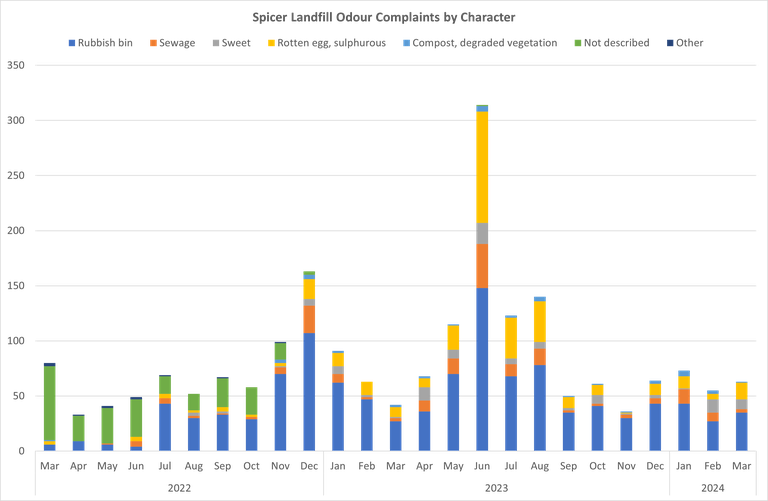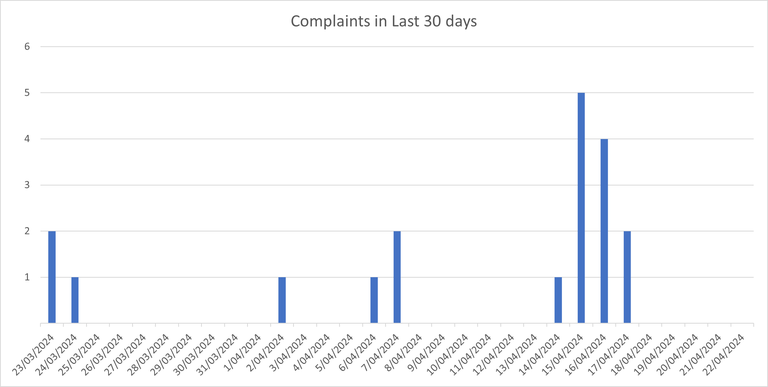

On this page you will find
Read our latest update on odour issues here.
Tawa residents near the landfill have had concerns about odour from the landfill off and on over the years. However, since December 2021 there has been an increase in the number of complaints received. We have been actively working to understand the nature of the issues, specific causes and have implemented several measures to try and address them.
A public meeting was held in April 2022 to discuss concerns and agree some steps forward. Questions raised prior to and during the meeting have been answered here: Odour Questions & Answers
In addition to the nine current measures being introduced to reduce odour (see FAQ below: What is being done about odour) we have also:
In late May 2022, Council’s landfill services consultant Tonkin + Taylor commenced a proactive odour monitoring programme where surveys are undertaken in a defined route around the Tawa residential area when specific weather conditions are present.
The monitoring surveys enable the collection of baseline data during conditions that typically coincide with more frequent complaints and avoids the pitfalls of relying on reacting to complaints only to find that conditions (and odour levels) have changed once the location of the odour is able to be attended.
This is helping us gain an improved understanding of ambient odour and odour levels in Tawa, associated with the current landfill, so that we can measure the impact of the improvements we trial and put in place. The programme helps us assess the frequency, intensity, duration, character, and tone of odour experienced in the area.
The methodology for observation and recording is consistent with European standards.
An air quality monitor has been installed in Westwood Road Tawa to provide another level of data to corroborate or discount what we think is happening. This monitor will help us rule in or out whether landfill gas is an issue.
The air quality monitor is calibrated to detect:
The monitor will not tell us if the air smells, but it will tell us if hydrogen sulphide is present (indicating landfill gas), if there is microscopic dust in the air and what the wind is doing.
This will help us corroborate what we might already be receiving in terms of complaints data. It provides an extra layer of certainty as it operates continuously so can give us an indication of what’s happening at any given point in time – something that can be difficult to ascertain if it takes a person 15 - 30 minutes to get to site to verify a complaint.
Data will be analysed and reported on monthly, on this page. An inbuilt alarm system will alert us immediately if there are unsafe levels of dust or hydrogen sulphide that need urgent action.
Below is the initial report on data collected from the air quality monitor and provides some detailed background information:
The following reports provide summary information on the data collected from the air quality monitor, and will be issued monthly from July:
Please call Porirua City council on 04 237 5089 or 0800 237 1500 and we will also notify Greater Wellington Regional Council.
Alternatively you can use our landfill odour complaint form or email [email protected]. Please note an email complaint may not be logged immediately.
When you report an odour complaint it is important that you provide the following information:
Smell characteristics
Which one of these is it most like?
Smell strength
On a scale of 1 to 6 tell us how bad it is:
1 = barely detectable
3 = distinctive
6 = extremely strong, inducing a physical reaction
Te Whatu Ora public health service have provided some advice for residents living near Spicer Landfill who are concerned about odour effects from the landfill impacting on their health.
You can access that advice here.
Our regulatory authority Greater Wellington Regional Council provides regular information on complaints received due to odour from the landfill.
The following graph shows the number of complaints received per month, since March 2022. This graph is updated on a monthly basis.
To view a larger image of this graph click here.

The next graph shows a 30-day rolling record of the number of complaints received. This graph is updated on a fortnightly basis.


We use several measures to control the odour from the landfill and this includes odour spray lines installed around the perimeter of the active landfill, applying daily cover to the active tip face every evening, and a thicker intermediate cover on areas no longer being filled.
We continually review our operations to ensure that we are doing the best we can to reduce the odour. Below are some initiatives that we are currently undertaking.

Spicer Landfill is a joint venture, owned by Porirua City Council (78.5 per cent) and Wellington City Council (21.5 per cent). The landfill is managed by Porirua City Council.
Porirua City Council (PCC) reports to a Joint Venture Committee which has representatives from both Porirua and Wellington City Councils (WCC).
EnviroWaste Services Ltd operates the landfill on behalf of the two Councils.

Greater Wellington Regional Council (GWRC) plays a regulatory role. They ensure the landfill is operating according to its resource consent conditions. GWRC also responds to complaints from the public.
Porirua City Council immediately notifies GWRC of all odour complaints received.

The wastewater treatment plant bio-solids accepted at Spicer Landfill comply with both the landfill resource consent and the landfill Waste Acceptance Criteria.
Wellington Water Ltd is contracted to run the wastewater treatment plant. Porirua City Council manages the contract.

The odour that residents smell is unpleasant but not dangerous.
Landfill staff who may be exposed to landfill gas, for example when working on the gas system or digging into the landfill, wear personal gas sensors.

The public health service have recommended if you have concerns about symptoms associated with the odour, to discuss this with your family doctor. It is useful to take with you any records of when you experience symptoms and how these are associated with the odour, for example, an odour diary you have been keeping. If your doctor is concerned your health issues may be directly due to chemical or particle exposures, with your permission, they can report this to the public health service for further investigation.
Please click here for further information.

To make a complaint about odour from the landfill refer to our How to make a complaint section above.

If you've complained by web form:
Your complaint is sent to Porirua City Council, Greater Wellington Regional Council and the landfill operator as soon as you hit submit. This is an automated, electronic process.
If you've complained by phone:
The customer service representative will log your complaint. This is normally while you are on the phone, but may be completed once you've hung up. Your complaint is sent to Porirua City Council, Greater Wellington Regional Council and the landfill operator. This is an automated, electronic process that happens once the customer service representative has completed the entry.
If you've complained by email:
Your email will be logged by a customer service representative during business hours only. This may be the next business day if you've emailed after hours. Your complaint is sent to Porirua City Council, Greater Wellington Regional Council and the landfill operator. This is an automated, electronic process that happens once the customer service representative has logged your email.


The monitor will be in place for approximately 6 months from late April – late October 2023. This gives a good window of time to gather some meaningful data.

There is a wide variety of potential odorous compounds, and it isn’t practical to measure all of these to the degree of accuracy that is required. Hydrogen sulphide is typically the most prevalent odorant associated with landfill waste decomposition and can be reliably measured.

This is an area of Tawa that we typically receive complaints from so seemed like a good starting point.

This will still be useful information as it will help us understand what may or may not be causing odour.

This is simply the soonest we can commence this monitoring. The landfill is used all year round, and history shows us that odour events may also occur all year round.

In the normal course of events, we will be receiving monthly reports and will provide information on these on this page.

We will be analysing it and comparing it to our complaints data to see whether there are any correlations. It will also help us to rule in or out whether landfill gas is a source of the odour.

The monitor will be set to immediately alert Council staff if there are high or unexpected readings detected, referring to the Ministry for the Environment’s Ambient Air Quality Guidelines for Hydrogen sulphide and National Environmental Standards for Air Quality relating to fine particles (PM10 – particulate matter less than 10 micrometres across).

We receive a text notification within about 15 mins of the alert level being reached. This then gives us the opportunity to assess what the problem is and take appropriate actions. Causes can include landfill gas escaping the gas collection system. Smoke from wood burners is a likely cause of high particulate readings in winter.

We are waiting for advice from our supplier as the original unit we were going to install was affected by flooding events earlier this year.

Levels of hydrogen sulphide where impacts on health are possible are fairly well documented and can be found on the Worksafe NZ website here. Odour detection of hydrogen sulphide occurs at much lower levels than where health impacts can occur. Specification of monitoring alert levels based on odour detection will therefore provide protection against health impacts.
A standard for fine particle concentrations is specified under the National Environmental Standards for Air Quality to protect human health. Fine particle concentrations will be compared with this standard.